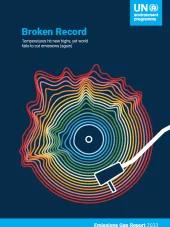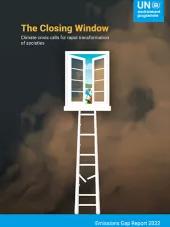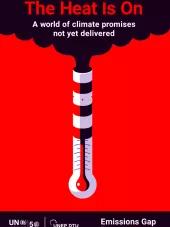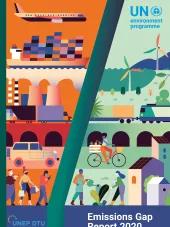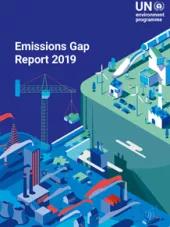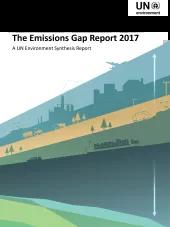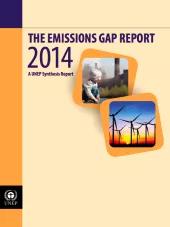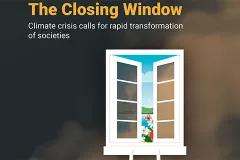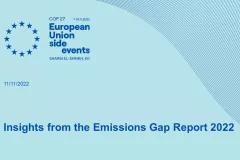This is the 2024 edition of the United Nations Environment Programme (UNEP) Emissions Gap Report series, which tracks our progress in limiting global warming well below 2°C and pursuing 1.5°C in line with the Paris Agreement. Since 2010, it has provided an annual science-based assessment of the gap between estimated future global greenhouse gas (GHG) emissions if countries implement their climate mitigation pledges, and where they should be to avoid the worst impacts of climate change. NewClimate Institute has been contributing to the reports each year since 2014.
For this year's report, NewClimate Institute staff was part of the steering committee (Niklas Höhne) and co-led and contributed to Chapter 3 on the global landscape of NDCs and G20 progress (Takeshi Kuramochi, Leonardo Nascimento, Frederic Hans, Silke Mooldijk) and Chapter 6 on sectoral transformation (Judit Hecke, Louise Jeffery).
"The world has lost too much time on inaction. The report shows that very large emission reduction opportunities still exist for 2030 and 2035, and some countries are already implementing them. Now, is the moment for all actors to make a quantum leap in ambition and action.” , says Takeshi Kuramochi, co-author of the UNEP Emissions Gap Report 2024.
"Every year that we wait adds to the damages that are already severe today. Equally every tonne of emission less will lead to less damages. The report shows again that the world has huge untapped potential to reduce greenhouse gas emissions. And if the transition is organised in the right way, the world will be a better place than it is today with cheaper energy services, less air pollution, more access to energy and transport." , adds Niklas Höhne, member of the UNEP Emissions Gap Report 2024 steering comittee.
Press release (abridged version focusing on chapter with NewClimate contributions):
Nations must close huge emissions gap in new climate pledges and deliver immediate action, or 1.5°C lost
- It is still technically possible to meet the 1.5°C goal, but only with a G20-led massive global mobilization to cut all greenhouse gas emissions, starting today
- Continuation of current policies will lead to a catastrophic temperature rise of up to 3.1°C
- Current commitments for 2030 are not being met; even if they are met, temperature rise would only be limited to 2.6-2.8°C
Cali/Nairobi, 24 October 2024 – Nations must collectively commit to cut 42 per cent off annual greenhouse gas emissions by 2030 and 57 per cent by 2035 in the next round of Nationally Determined Contributions (NDCs) – and back this up with rapid action – or the Paris Agreement’s 1.5°C goal will be gone within a few years, according to a new UN Environment Programme (UNEP) report.
Updated NDCs are to be submitted early next year ahead of the COP30 climate talks in Brazil. UNEP’s Emissions Gap Report 2024: No more hot air … please! finds that a failure to increase ambition in these new NDCs and start delivering immediately would put the world on course for a temperature increase of 2.6-3.1°C over the course of this century. This would bring debilitating impacts to people, planet and economies.
The 2.6°C scenario is based on the full implementation of current unconditional and conditional NDCs. Implementing only current unconditional NDCs would lead to 2.8°C of warming. Continuing with current policies only would lead to 3.1°C of warming. Under these scenarios – which all operate on a probability of over 66 per cent – temperatures would continue to rise into the next century. Adding additional net-zero pledges to full implementation of unconditional and conditional NDCs could limit global warming to 1.9°C, but there is currently low confidence in the implementation of these net-zero pledges.
“Climate crunch time is here. We need global mobilization on a scale and pace never seen before – starting right now, before the next round of climate pledges – or the 1.5°C goal will soon be dead and well below 2°C will take its place in the intensive care unit,” said Inger Andersen, Executive Director of UNEP. “I urge every nation: no more hot air, please. Use the upcoming COP29 talks in Baku, Azerbaijan, to increase action now, set the stage for stronger NDCs, and then go all-out to get on a 1.5°C pathway.
1.5°C still technically possible, but massive effort needed
The report shows that there is technical potential for emissions cuts in 2030 up to 31 gigatons of CO2 equivalent – which is around 52 per cent of emissions in 2023 – and 41 gigatons in 2035. This would bridge the gap to 1.5°C in both years, at a cost below US$200 per ton of CO2 equivalent.
Increased deployment of solar photovoltaic technologies and wind energy could deliver 27 per cent of the total reduction potential in 2030 and 38 per cent in 2035. Action on forests could deliver around 20 per cent of the potential in both years. Other strong options include efficiency measures, electrification and fuel switching in the buildings, transport and industry sectors.
This potential illustrates it is possible to meet the COP28 targets of tripling renewable energy capacity by 2030, doubling the global average annual rate of energy efficiency improvements by 2030, transitioning away from fossil fuels, and conserving, protecting and restoring nature and ecosystems.
However, delivering on even some of this potential will require unprecedented international mobilization and a whole-of-government approach, focusing on measures that maximize socioeconomic and environmental co-benefits and minimize trade-offs.
A minimum six-fold increase in mitigation investment is needed for net-zero – backed by reform of the global financial architecture, strong private sector action and international cooperation. This is affordable: the estimated incremental investment for net-zero is US$0.9-2.1 trillion per year from 2021 to 2050 – investments that would bring returns in avoided costs from climate change, air pollution, damage to nature and human health impacts. For context, the global economy and financial markets are worth US$110 trillion per year.
The G20 members, responsible for the bulk of total emissions, must do the heavy lifting. However, this group is still off track to meet even current NDCs. The largest-emitting members will need to take the lead by dramatically increasing action and ambition now and in the new pledges.
G20 members, minus the African Union, accounted for 77 per cent of emissions in 2023. The addition of the African Union as a permanent G20 member, which more than doubles the number of countries represented from 44 to 99, brings the share up by only 5 per cent to 82 per cent – highlighting the need for differentiated responsibilities between nations. Stronger international support and enhanced climate finance will be essential to ensure that climate and development goals can be realized fairly across G20 members and globally.
Good NDC design crucial
The report also lays out how to ensure the updated NDCs are well-designed, specific and transparent so they can meet any new targets put in place. NDCs must include all gases listed in the Kyoto Protocol, cover all sectors, set specific targets, be explicit about conditional and unconditional elements and provide transparency around how the submission reflects a fair share of effort and the highest possible ambition.




